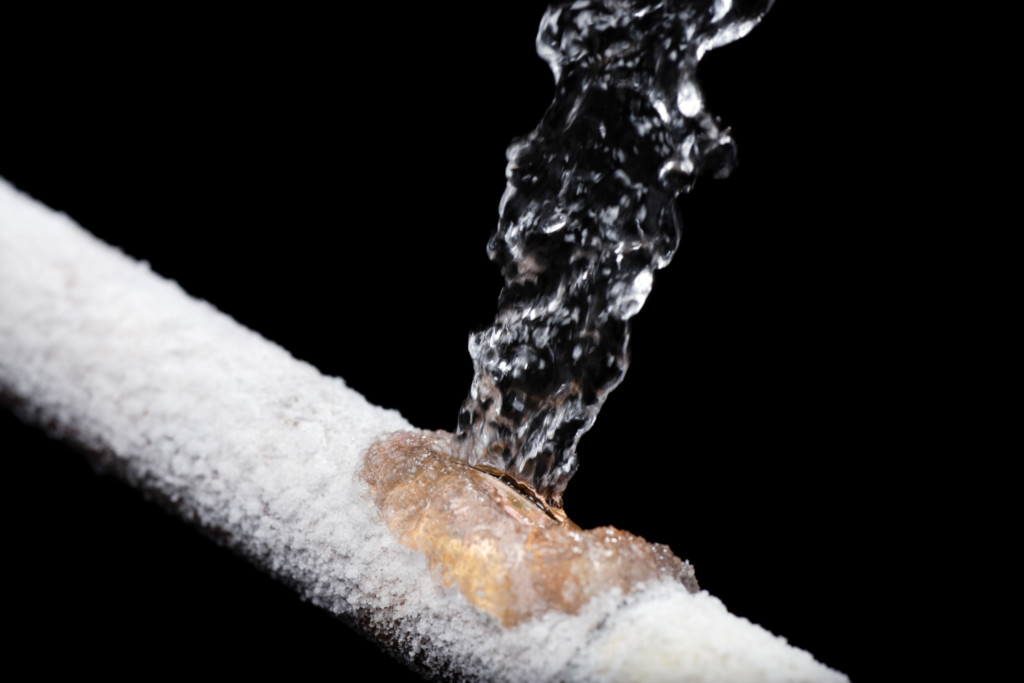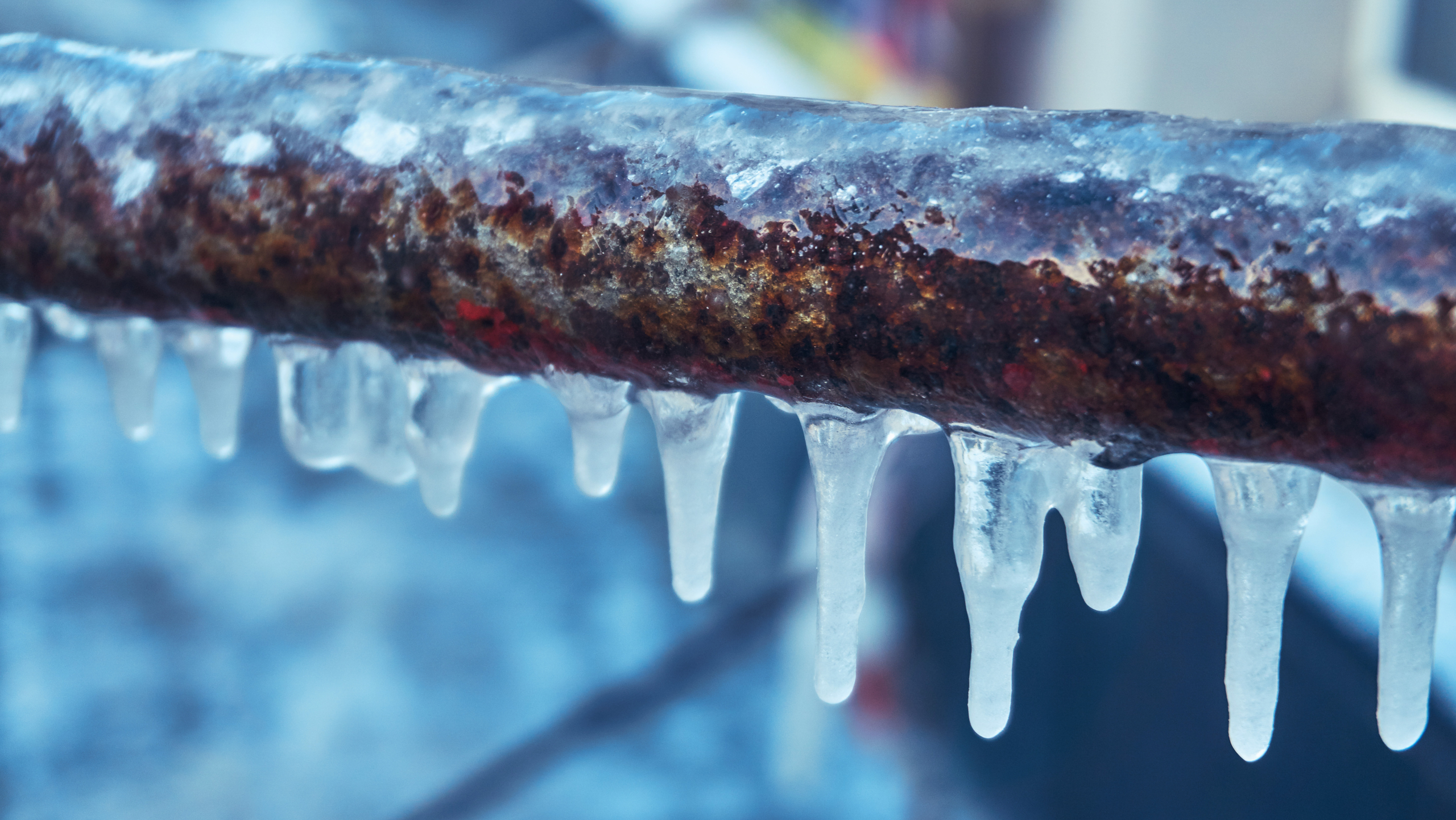It’s a homeowner’s nightmare – temperatures fall, pipes freeze and burst, and suddenly the basement, kitchen, or bathroom is filled with water. This nightmare can get even worse when holiday travel or property damage is factored in. Thankfully, there are steps any homeowner can take to prepare their homes, respond to changing weather, and seek out help if disaster strikes.
What Causes Burst Pipes?
Most spaces in the home are what are known as “conditioned spaces.” These are areas that are temperature and humidity controlled thanks to the home’s HVAC systems. Pipes that run through these areas are less likely to be exposed to extreme temperatures. However, in many cases, pipes run through areas that can be high-risk in the winter months.
Some high-risk pipes can be found in these areas.
- Underground.
- Along exterior walls.
- Through unconditioned spaces.
- Basements.
- Crawlspaces.
- Attics.
- Garages.
When pipes run through these spaces, they are vulnerable to below-freezing winter temperatures. These pipes, which can include sprinkler systems, outdoor faucets, and plumbing for sinks and toilets, are at the highest risk of freezing.
As temperatures drop, water in a pipe can freeze. This freezing causes the water to expand, putting extreme pressure on the pipes and plumbing joints, sometimes causing them to crack or burst. In some cases, very low temperatures can even cause the water in a toilet to freeze and crack the porcelain tank!
When pipes are completely frozen, a homeowner may not be able to see water leaking from them. However, once the frozen pipe thaws, water can begin dripping or streaming out of pipes and into basements, bathrooms, or even walls. This water can cause immediate damage to property and belongings, and even worse, contribute to potential mold issues down the road. By the time a leak is visible, it may already be too late to head off damage.

An Ounce of Prevention
As we all know, there’s no controlling the weather. What is a homeowner to do to reduce the risk of frozen pipes, ensuring their water keeps flowing, their home stays dry, and their property stays safe? The best thing a homeowner can do to keep their home safe from frozen or burst pipes is to conduct a walkthrough to assess areas of risk, identify important elements of their water system, and ensure they are prepared to respond in case of a burst pipe.
Identify and Protect Vulnerable Plumbing
As we’ve learned, pipes that run through or along unconditioned spaces are at the highest risk of freezing. During a walkthrough, be sure to identify all locations where pipes may be at risk.
Areas to look at during an assessment include…
- Pipes that run along exterior walls.
- Pipes that are located in attics and crawlspaces.
- Pipes that are located in garages.
Normally, these pipes are insulated, but if they aren’t, there are simple steps that property owners can take to protect them.
Install Pipe Insulation
A simple step to help protect them is installing pipe insulation. This can come in the form of adhesive “pipe tape” or as foam sleeves that fit around them to keep heat in and cold out.
Fit Outdoor Spigots With Styrofoam Covers
Outdoor spigots can also be fitted with simple Styrofoam covers that keep external temperatures from getting inside.
Open Cabinets to Encourage Warm Air Flow
Next, be sure that warm air from the rest of the house can reach pipes that may be exposed to cold temperatures. To accomplish this, simply open cabinet doors under items like kitchen and bathroom sinks.
Turn On Faucets to a Slight Drip
Another step is to keep water moving through these pipes by opening faucets very slightly to allow a trickle of cold water. Encouraging water to flow reduces the chances of sitting water freezing.
The Importance of Water Shut-Off Valves
A pipe burst can be devastating, and the chances of a large-scale water damage event are made greater when residents don’t know enough about their water shutoff valve. Here’s how to better understand shut-off valves and how they can help.
Locate and Note The Location of All Water Shut-Off Valves
Locate and note where water shut-off valves are, including the main shut-off and any other valves in the system. These valves will generally take the form of a straight lever or a round or oval-shaped handle that is connected to the incoming water line. Turning these handles will cut off the water supply to any downstream pipes and fixtures.
Shut Off Water to Exterior Spigots and Faucets
Be sure to drain these systems of water. It may be helpful to call a trusted plumber to walk through this part of the system and explain the various shutoff valves that are present. Knowing the location and operation of these valves could mean the difference between a damp floor and a fully flooded basement.
Be Aware of Other At-Risk Systems
In extreme low temperatures, frozen pipes are not just a concern in the kitchen and bathroom. With low enough temperatures, any system that contains water could potentially freeze and burst.
Some additional items to keep an eye on include…
- Toilet tanks and bowls.
- Radiant heating systems
- Sprinkler systems.
Identify these systems and be sure to check on them when temperatures fall.
Have a Plan
Even careful homeowners may experience a pipe burst. That’s why it is important to have a plan for how to respond if things go wrong.
Here are a few important things to know in case of an emergency.
- How to shut off the water supply to ruptured pipes.
- How to divert water from a leak.
- Which plumbing company to call for repairs.
- Who to contact to help with the recovery process once leaks are fixed.
Not Home for the Holidays?
The holiday season is prime time for cold weather and the risk of frozen pipes. With the holidays come a lot of travel. Visiting family and friends means being away from home and being unable to monitor for potential frozen or burst pipes.
If Forecasts Call For Extreme Lows, There are Ways to Help Protect a House.
Keep the home’s thermostat set to at least 50° F/10° C. Wi-Fi-enabled thermostats provide a way to monitor and adjust temperatures even from afar. Cloud-connected cameras can help keep an eye out for leaks or pooling water. Want to keep it low-tech? Ask a trusted neighbor or friend to check in periodically for any issues that may arise.

How to Thaw Frozen Pipes
If preventative measures aren’t enough and pipes freeze, what can be done to defrost frozen pipes? One way to help thaw a frozen pipe is to use a hair dryer or heater to gradually apply warm (not hot) air to the area. Another option is to open any cabinet doors under the sink to allow warmer air to reach the plumbing. Fans can also be used to help increase the flow of warm air around frozen pipes. In any case, warming the area gradually is important. Too much heat too fast can also cause damage. Frozen pipes may not always lead to burst pipes, but it is important to be aware that if damage has occurred, leaks will begin to appear as the water starts flowing again.
What to Do If A Pipe Bursts
In case of a burst pipe, quick action is necessary to stop or slow the flow of water and limit the damage. These include using the water shut-off valve, clearing the affected area of belongings, and ensuring nearby drains are clear. Drying the affected area as quickly as possible is also important.
The main long-term concern with a water leak is the potential for mold. If moisture remains in the area as temperatures begin to warm, there is a risk that mold may begin to develop. Homeowners should exercise extreme caution in cases of flooded basements. Standing water in these spaces can increase the risk of electrocution.
When all else fails and damage occurs, the most important thing a homeowner can do to help mitigate issues and recover their property to pre-storm condition is to find a trusted disaster recovery partner like First Onsite to guide them through the recovery process. These companies have a wealth of experience in responding to frozen or burst pipes and water damage. They can identify potential risk areas before a problem occurs and can help make things right if disaster strikes.
